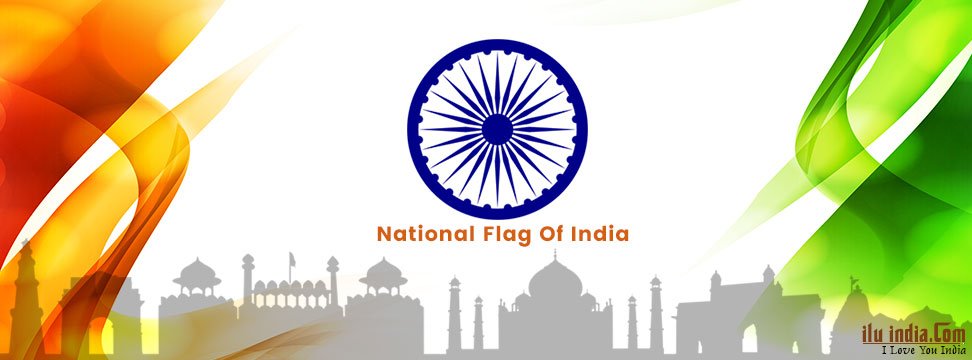
National Flag Of India
The Indian National Flag indicates hopes and aspirations of the people of India. It is the Symbol of Our national pride.
The National flag of India is popularly known as Tiranga ( तिरंगा ) meaning ‘tricolor’. The Indian national flag is a horizontal tricolor in equal proportion of deep saffron (kesari) on the top, white in the middle and dark green at the bottom. The ratio of width of the flag to its length is 2:3. In the center of the white band, is a wheel in Navy blue color which represents the Dharma Chakra or the ‘Wheel of Law’.
The top saffron color indicates the strength and courage of the country. The white color in the middle, indicates truth,peace and purity. At the center of the white band is a navy blue wheel known as Dharma Chakra (The Wheel Of Law), which represents Ashoka Chakra at Sarnath. The wheel has 24 spokes. The green colour in the bottom symbolize the prosperity, fertility , growth and auspiciousness of the land.
The design of the National Flag was adopted by the Constituent Assembly of India on 22 July 1947. The flag was subsequently retained as that of the Republic of India. In India, the term “tricolour” almost always refers to the Indian national flag. The Indian national flag was designed in 1916 by Pingali Venkayya from Machilipatnam. The tricolour flag designed by him, with a charkha in the centre was adopted by the Congress committee in 1931 at Karachi.
The significance of the colours of the flag:
Saffron: Saffron is a symbol of strength, courage, sacrifice and the spirit of renunciation of the country.
White: The white colour represents peace, truth and purity of the country.
Green: The green colour shows the faith,fertility, growth, prosperity and auspiciousness of the land.
Ashoka Chakra: The Ashoka Chakra or the Dharma Chakra (Wheel of Law) represents the righteousness, progress and perpetuity of the country.
Indian Flag Code:
Usage of the flag is governed by the Flag Code of India and other laws relating to the national emblems.The original code prohibited use of the flag by private citizens except on national days such as the Independence day and the Republic Day.
On 26th January 2002, on hearing an appeal from a private citizen, Naveen Jindal, the Supreme Court of India directed the Government of India to amend the code to allow flag usage by private citizens. The flag code was changed after 52 years, the citizens of India are free to fly the Indian flag over their homes, offices and factories on any day. Now Indians can proudly display the national flag anywhere and anytime.
Rules Governing Display of National Flag by Citizens and, Private and Educational Organizations
There is no restriction on the display of National Flag by members of the general public, private organizations, educational institutions only they have to follow all the prescribed rules. The following important things have to be kept in mind:
- The flag should not be used for commercial purposes
- The flag should not be dipped to salute any person
- The flag should not be used as a portion of costume or uniform. It should not be embroidered or printed on cushions, handkerchiefs, napkins or any dress material
- No lettering of any kind should be put on the flag
- The flag should not be used as a receptacle for receiving, delivering, holding or carrying anything
- The flag should not be intentionally displayed with ‘saffron’ down
- The flag should not be used to cover a speaker’s desk and it should not be draped over a speaker’s platform
- A damaged or dishevelled flag should not be used
- The flag should only be displayed from sun-rise to sun-set
Sizes of the National Flag
As per the Flag Code of India and the Indian Bureau of Standards there are nine standard sizes of our National-flag. Earlier, they were only five which were later increased to seven. Flags of larger dimension can be made keeping the ratio of 3:2.
| Serial No. | Dimensions | Size of Ashoka Chakra (MM) | Generally Used On | |
| In Feet & Inches | In MM | |||
| 1. | 21′ x 14′ | 6300 x 4200 | 1295 | On high flagmasts / domes |
| 2. | 12′ x 8′ | 3600 x 2400 | 740 | Red Fort (Delhi), Rashtrapati Bhawan, Gun Carriage |
| 3. | 9′ x 6′ | 2700 x 1800 | 555 | Parliament House and other medium size public buildings |
| 4. | 6′ x 4′ | 1800 x 1200 | 370 | Small size public buildings and during State and military funerals |
| 5. | 4.5′ x 3′ | 1350 x 900 | 280 | Smaller size public buildings |
| 6. | 3′ x 2′ | 900 x 600 | 185 | In rooms on cross bars against walls |
| 7. | 18” x 12” | 450 x 300 | 90 | VVIP’s aircraft and President’s train |
| 8. | 9” x 6” | 225 x 150 | 40 | VVIP’s motor cars |
| 9. | 6” x 4” | 150 x 100 | 25 | Used as table flags |
Materials 3.1.2.2: Colours
Below is the list of specified shades for all colours used on the national flag, with the exception of Navy Blue, from “IS1: Manufacturing standards for the Indian Flag” as defined in the 1931 CIE Colour Specifications with illuminant C. The navy blue colour can be found in the standard IS:1803-1973.
| Colour | X | Y | Z | Brightness |
| White | 0.313 | 0.319 | 0.368 | 72.6 |
| Indian Saffron (Kesari) | 0.538 | 0.360 | 0.102 | 21.5 |
| Indian Green | 0.288 | 0.395 | 0.317 | 8.9 |
Note that the values given in the table correspond to CIE 1931 color space. Approximate RGB values for use may be taken to be: India saffron #FF9933, white #FFFFFF, India green #138808, navy blue #000080. Pantone values closest to this are 130 U, White, 2258 C and 2735 C.
Insult to the National Flag will attract a prison term of 3 years
As per Section 2 of ‘The Prevention of Insults to National Honour Act, 1971’– Whoever, in any public place or in any other place within public view, burns, mutilates, defaces, defiles, disfigures, destroys, tramples upon or otherwise shows disrespect to or brings into contempt (whether by words, either spoken or written, or by acts) the Indian National Flag or any part of it, shall be punished with imprisonment for a term which may extend to three years or with fine, or with both.
History of Indian Flag Facts About Indian Flag List of Indian Flags





